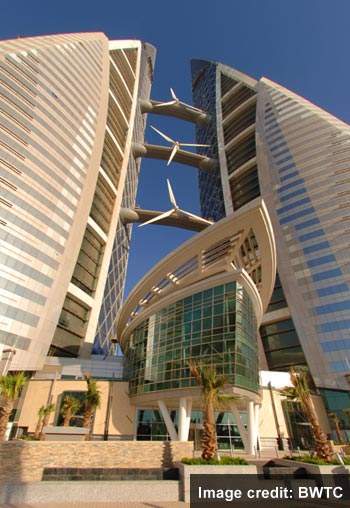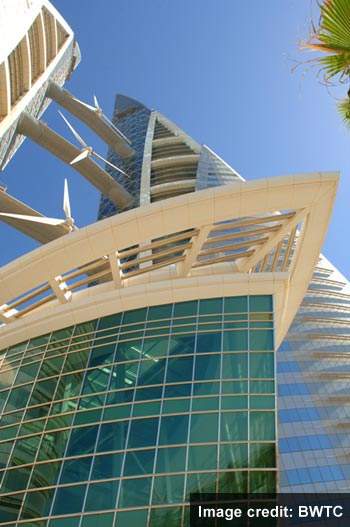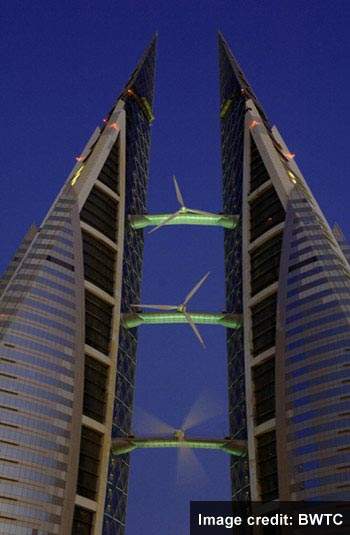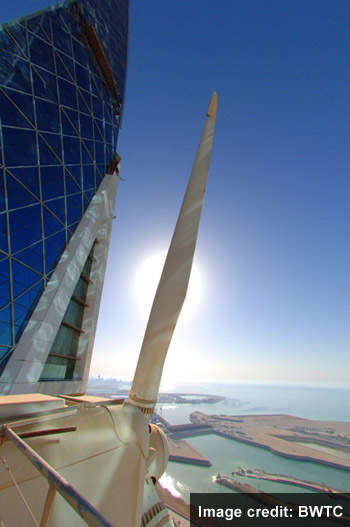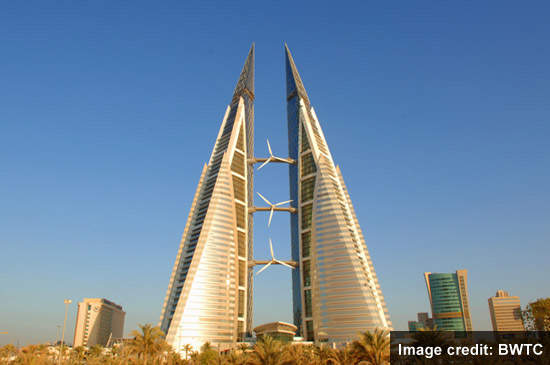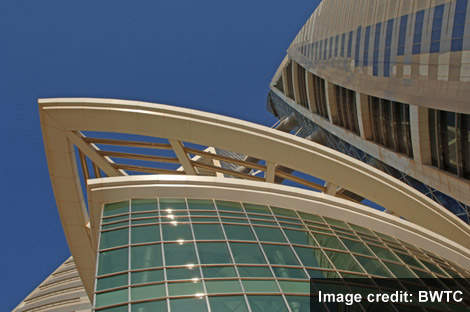The Bahrain World Trade Centre (WTC) on the King Faisal Highway in Manama is an extension of the existing five-star Sheraton Hotel complex (a rejuvenation) and comprises two 50-storey sail-shaped commercial office towers, which taper to a height of 240m and support three 29m diameter horizontal-axis wind turbines. The Bahrain WTC offers unobstructed views over the Arabian Gulf.
The towers are integrated on top of a three-storey podium, which accommodates a new 9,600m² MODA shopping centre (200 boutique stores including Versace, Yves St Laurent, Hermes and Dolce, Tiffanys, van Cleef and Arpel and Gabbana), fine restaurants, food court, hotel space for the Sheraton, business centre, health club and spa, and 1,700 onsite parking spaces.
The podium accommodates a one-storey extension to the existing shopping mall to give a total floor space of 16,500m². This has been carried out to preserve the established modular, axial and spatial parameters of the development. The towers were officially opened in mid-2008.
Designed by the architect Atkins, the Bahrain WTC won several awards for the incorporation of renewable energy into its large-scale building design, including the 2009 NOVA Award in Innovation for integrating technology to improve quality and reduce development cost.
The WTC was also awarded the Best Tall Building Award, Mena Region for 2008, the EDIE Award for Environmental Excellence for 2007 and the LEAF Award for Best Use of Technology within a Large Scheme for 2006. Atkins won the Architect of the year 2008 award from the Building Design Awards for the Bahrain WTC.
Bahrain WTC environmental considerations
The Bahrain WTC has an intelligent and environmentally responsive design. Enough buffer spaces have been incorporated between the external environment and air-conditioned spaces to reduce solar gain on the building. Two car park decks above and on the southern side of the building minimise solar air temperature, contributing to a low solar gain. Further, there are deep gravel roofs that provide kinetic insulation.
Additional high-quality solar glasses used with low-shading coefficient reduce the air temperature of the building. Balconies to the sloping elevations with overhangs also provide appropriate shading. The opaque fabric elements of the building are given enhanced thermal insulation.
Atkins have carved a connection to the district cooling system, which works on sea water cooling / heating rejection and has a high-energy conversion efficiency contributing to low-carbon emissions. Chilled water is used to cool the building and the entire complex. There are also reflection pools at entry points of the building, providing local evaporative cooling.
Moreover, extensive landscaping reduces site albedo, generates CO2 and shades the on-grade car parks. Additionally, low-leakage, openable windows installed in the building support the mixed-mode operation in winter months.
Inside the building, dense concrete core and floor slabs balance loads and reduce peak demand contributing to a low use of air and chilled water transport systems. Variable-volume chilled water pumping takes less power to operate than conventional pumping.
Moreover, there is a low-pressure loss distribution for primary air and water transport systems requiring less fan and pump power. The building has two drainage systems separating foul and waste water. A solar-powered road, amenity lighting and high-frequency, energy-saving fluorescent lighting with zonal control are also included in the design of the building.
Bahrain WTC wind power
Inspired by Arabian wind towers (Atkins chief architect Shaun Killa was responsible for the design), the sail-shaped towers funnel the sea breeze into the three 29m-diameter wind turbines. The turbines are supported by three sky bridges that connect the two towers. They act as aerofoils, funnelling and accelerating the wind velocity between them.
The vertical sculpting of the towers also progressively reduces the pressure so that when combined with the rising velocity of the onshore breeze at increasing heights, a near equal regime of wind velocity on each turbine is achieved.
Understanding this phenomenon has been a key factor behind the success of this design. Extensive wind tunnel testing also confirmed how the shapes and spatial relationship of the towers sculpt the airflow, creating an ‘S’ flow. This ensures that within a 45° wind angle either side of the central axis, the centre of the wind stream remains perpendicular to the turbines.
The elliptical shaped towers act as aerofoils, funnelling and accelerating the wind velocity between them.
In this way, the turbines’ potential to generate power is dramatically increased. The turbines produce between 11% and 15% of the building’s electricity needs (generating between 1,100MWh and 1,300MWh a year) and operate for 50% of the time with full power being generated at a windspeed of 15m/s to 20m/s.
The generators are of a four-pole 400V asynchronous induction type, which require little maintenance and can be controlled by centres established in the towers. There have been provisions made to mount small cranes on all three bridges to undertake maintenance and replacement of components on the turbines.
The three wind turbines, which have a 20-year life, were lifted into place in March 2007 and commissioned in October 2007. In April 2008, the three wind turbines turned together for the first time. The total output of each turbine is 225MW and they have been mounted at 60m, 98m and 136m high between the two towers.
This is the first successful large-scale implementation of wind turbines in a building. The problem in the past has been the high cost of developing the turbines, which can amount to up to 30% of the cost of the building. In this project, the costs have only been around 3.5% of the total project cost because of the use of more off-the-shelf technology for the turbines.
Other features
The building also incorporates a large number of other sustainable features that make it environmentally responsive in reducing carbon emissions. These include water recycling, connection to the district cooling system, thermal insulation, reflection pools for evaporative cooling, low-leakage windows and thermal glass with a low solar gain.
The BWTC sets a precedent that wind turbine integration is possible in a built environment. It places environmental design at the forefront of clients’ and designers’ agendas in a highly visual way, and will hopefully help to initiate more energy conscious developments worldwide. The cost of the wind turbine technology is not prohibitive and this project sets a benchmark for future projects.

